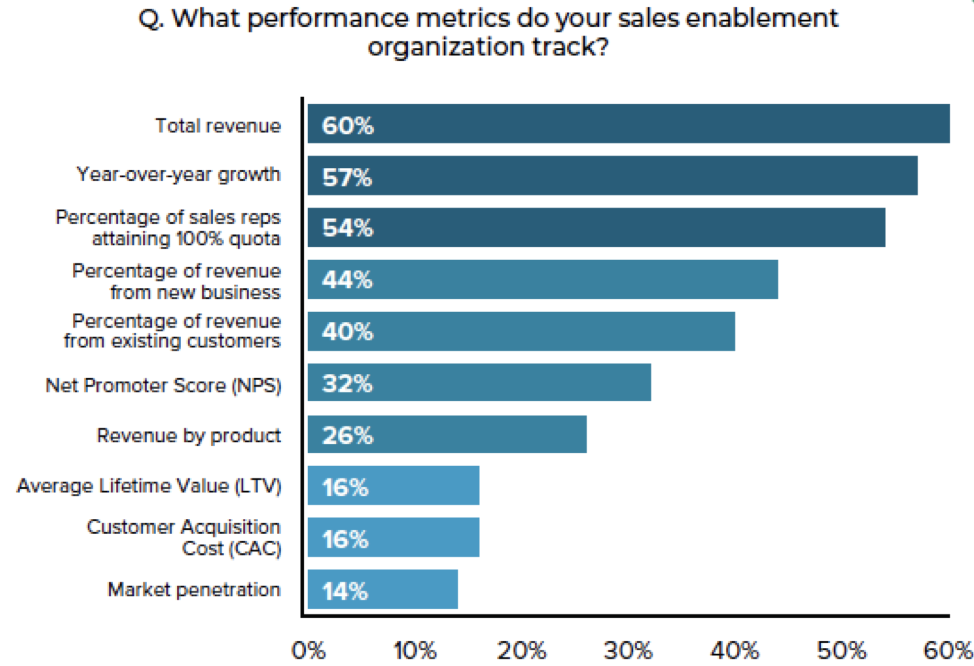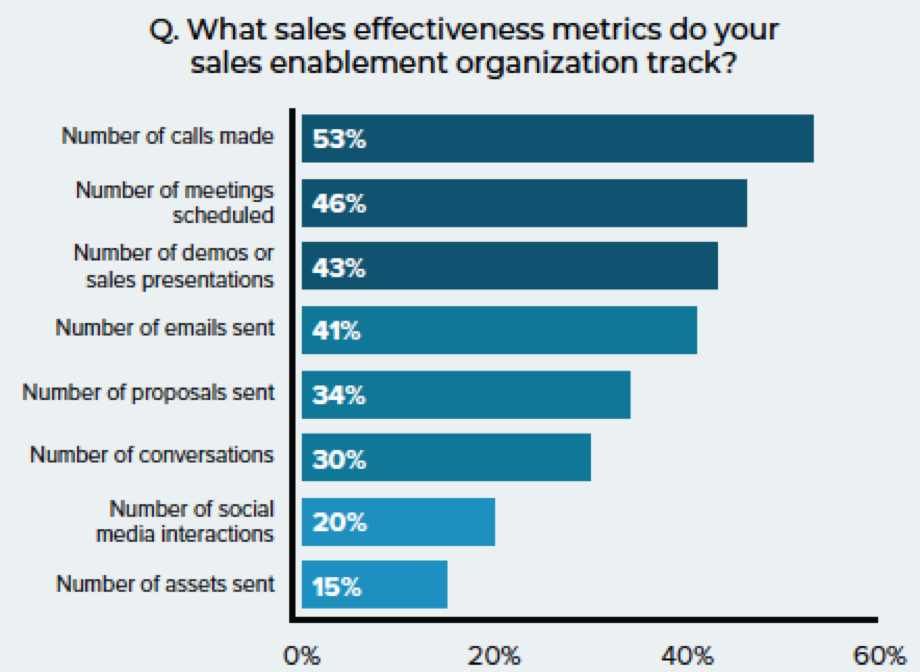If you ask the C-Suite in any organization what sales performance and pipeline metrics they care about, you’ll likely find a similar list. Traditional, strategic metrics such as total revenue, year-over-year growth, and quota attainment are consistently top priorities, and for good reason — these are the make-or-break numbers that determine the health and longevity of a business.
By default, that means sales enablement has a responsibility to improve these. But as just one factor involved in influencing these strategic metrics, sales enablement needs to define its role in doing so. One strong lever — though arguably harder to measure — is behavior change.
Most sales enablement practitioners are aligned with the C-Suite in prioritizing these broader business metrics. In fact, the Sales Enablement Analytics Report 2019 found that total revenue, year-over-year growth, and quota attainment are the top three metrics tracked by sales enablement, with more than half of respondents measuring each.

And with a high potential for improving business impact, they should remain key priorities:
- Those that track total revenue experience a win rate that is 5 points more than those that do not.
- Those that track year-over-year growth experience a win rate is 4 points more than those that do not.

However, it is difficult to claim impact on metrics that are so wide-sweeping and inherently dependent on multiple facets of the business without first defining the sales behaviors needed for each.
“Making the jump from, ‘we did this initiative or training’ to ‘it had this impact on total revenue’ is a really large leap, and I think we need to break it down even further to pinpoint the specific areas where we supported that,” said Whitney Sieck, director of enablement at Greenhouse Software.
In breaking down sales performance metrics by behavior, sales enablement practitioners can focus in on areas where they can truly deliver the most impact. To prioritize behavior change in conjunction with sales performance, practitioners should begin by addressing three critical factors: leadership alignment, quality of activity, and frontline managers.
Leadership Alignment
Measuring behavior change can be challenging. To do so, sales enablement needs to define and secure buy-in from sales leadership for the behavior outcomes they want to see. If the C-level does not have visibility into the behavior change that sales enablement is aiming for, and more importantly how that impacts overall performance goals, then sales enablement will always be fighting an uphill battle.
Sales enablement practitioners need to ensure that behavior is included as a part of every presentation and conversation about goals and results with the C-level leaders. By making behavior change an expectation with the leadership team, sales enablement can better align its programs to overarching business goals. Further, sales enablement can more clearly articulate the ways in which it was a catalyst in reaching sales performance goals.
“In order for us to impact what it is that the C-Suite is measuring, we need to have a behavioral metric on their dashboard,” said Bob Britton, director of sales enablement at Netsurion. “There is none on most organization’s dashboards. So we have to start building in things that draw the correlation, that help them draw the right connection between, ‘this behavior in the organization changed, therefore this number changed.’”
Quality of Activity
Sales teams often track activity numbers in order to set benchmarks for what success looks like. When it comes to measuring sales effectiveness, such metrics are also common for sales enablement practitioners to track. The Sales Enablement Analytics Report 2019 found that 53% track the number of calls made, 46% the number of meetings scheduled, and 43% the number of demos.

However, focusing too heavily on pushing activity alone could inadvertently encourage behavior that doesn’t breed success. Instead, sales enablement needs to begin drawing the correlation to activity based on positive behaviors that truly impact performance.
For example, consider the response rate compared to the number of emails sent to understand the quality of the message. Or, look at the percentage of demos that move forward to the next stage to start to assess trends in the quality of presentations.
“The data you have is only going to be useful in the context of where it’s implemented,” said Greg McBeth, head of revenue at Node.io. “So, if you tell someone that they have to make 22 touches, and they go about and do that in the lowest quality way, not only is that not going to get the results you want, that’s going to hurt your brand, that’s going to hurt additional people on your team and their ability to go in and execute upon that.”
By digging deeper to understand the behavioral context of the data, sales enablement practitioners can more accurately identify and address underlying issues in behavior.
“It’s really around giving those benchmarks, that guidance, and those frameworks on what excellence looks like alongside the data,” said Nikki Curtis, head of sales enablement at Slack. “I always think it’s a balance between the human, the touch, the art of selling, plus what the data are telling us.”
Frontline Managers
Frontline managers play a critical role in driving behavior change. Sales enablement cannot observe every customer interaction, so sales enablement practitioners largely rely on frontline managers to be the eyes and ears in the field.
Deeply embedded in the day-to-day activities of their team, frontline managers should have visibility into the behavioral competencies of each sales rep. Therefore, sales enablement needs to ensure that frontline managers are enabled to support their teams by recognizing and reinforcing positive sales behaviors.
Coaching is one of the key ways frontline managers can champion behavior change within their teams. However, many organizations do not currently have formal and consistent coaching mechanisms in place to do so, as 42% have only ad hoc coaching or no regular coaching sessions at all at their organizations.
For frontline managers to be able to successfully coach and enable their teams around the behavioral outcomes that sales enablement is driving, they need to be enabled, as well. Sales enablement needs to partner closely with frontline managers and give them to tools to effectively coach and support behavior change.
By providing frontline managers with the training and frameworks to carry out productive coaching sessions, and also bring them in to help provide insight and context around what the data is showing in terms of behavior. This will help sales enablement better identify behavior changes that are needed and equip frontline managers to coach more effectively.
“My philosophy is that the data is the magic behind letting us know where we actually need to lean in more…on the coaching side,” said Curtis. “You can look at it on the individual one-on-ones, or you can look at it on a trend basis…You can’t have one without the other. You need the data to inform where you really need to build the learning infrastructure around coaching.”
As sales enablement continues to concretely define its role in impacting sales performance, proficiency, and productivity, behavior change must be elevated as a core area of focus. While strategic business metrics are necessary to help guide sales enablement toward the right priorities for the business, it will become increasingly important for sales enablement to connect the dots between its programs and those outcomes in order for sales enablement to gain more authority. By focusing on the behavior change that sales enablement initiatives catalyze, practitioners can better demonstrate the tangible business impact of sales enablement.
Read the Sales Enablement Analytics Report 2019 for more information.





